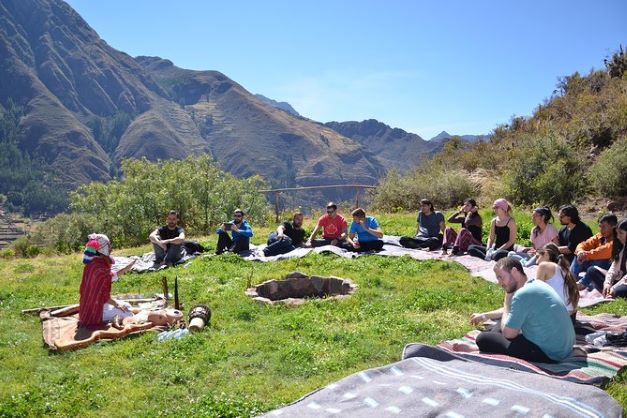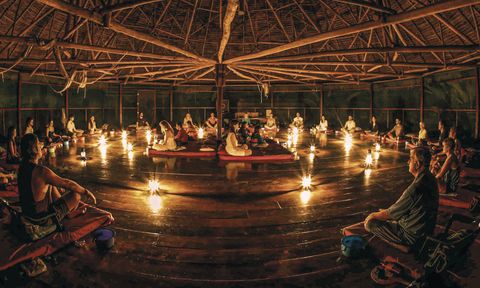There are those who consider ayahuasca as a drug, while those who consume it believe that it is a medicinal drink, but what is it? This tea is the result of mixing two plants found in the Amazon area: the ayahuasca vine (Banisteriopsis caapi) and a bush called chacruna (Psychotria viridis), which contains the hallucinogen dimethyltryptamine (DMT).
The chagropanga (Diplopterys cabrerana) also contains this substance, with this plant you can also prepare this drink. The mixture of both plants is capable of inducing altered states of consciousness in the person who has taken the drink, and its effects can last between four and eight hours. Peru
People usually present hallucinations of all kinds and that is why in the Amazon jungle it is ingested accompanied by a spiritual guide or shaman and after performing a special ritual.

ceremonia-ayahuasca 
ceremonia-ayahuasca
What is the Ayahuasca Ceremony?
Ayahuasca Ceremony is the psychedelic concoction ritually used by shamans, healers or ayahuasca teachers of the Amazon ethnic groups —for more than five thousand years— as a way to obtain the expansion of consciousness.
For those who ingest it, ayahuasca is a medicinal drink and is used in some rehabilitation therapies to fight addictions, which is why in recent years its consumption has increased outside the Amazon jungle.
DMT, the psychedelic or hallucinogenic substance found in the tea that is prepared, is found in nature (in addition to plants, it is also in mammals) and is a neuroreceptor that is related to the REM phase of sleep, at the moment when dreams occur. Although in this case, when ingesting the drink the experience usually occurs awake.
Ayahuasca Medicine
There are two stages of this experience that are worth highlighting, the imminent and tangible, which happens during the eight hours after taking it, that is to say, that awakening and dying at the same time. The later one is that of the work of every day after taking it. I took the liberty before narrating the rush of my direct experience, of letting the “twenties” fall and seeing how everything that manifested that day flows and transits.
The pharmacokinetic properties of Ayahuasca Medicine
Ayahuasca Medicine and addiction treatment
The literature suggests that the traditional consumption of Ayahuasca Medicine in the social framework has a minimal risk of potential abuse or in the formation of dependency (Gable, 2007).
The Takiwasi center in Peru where addiction treatment is provided using ayahuasca (with an average of 20 sessions over 6 months) as the core component of the therapeutic protocol (Mabit, 1996) conducted a study that has reported the first 175 patients who participated from 1992 to 1997, of which 67% were dependent on basic cocaine paste and 80% on alcohol or alcohol and other substances. The follow-up of the participants for at least two years after leaving the center showed that 54% avoided relapse, and additionally they demonstrated indicators of social and professional reintegration, family support capacity (Mabit, 2002).
Therapeutic use of Ayahuasca Medicine in neurodegenerative diseases
The inhibition of MAO by harmine and harmaline provides protection against neurodegeneration, and has potential therapeutic value for the treatment of Parkinson’s disease (Serrano, Cardozo and Sánchez, 2001).
Harmine has been tested in parkinsonian models and has increased striatum dopamine flux in rodents (Schwarz et al., 2003). In addition to its antioxidant action and MAO inhibitor-dependent mechanisms, harmine can also inhibit DYRK1A, as well as neurofibers associated with Alzheimer’s disease (Sitz et al., 2008).
Use of Ayahuasca Medicine in anxiety and depression
MAOIs have been used in the treatment of depression (Stahl and Felker, 2008) and in Parkinson’s disease, as mentioned in the previous section. For this reason, psychedelics can correctively modulate the prefrontal-limbic circuitry that is involved in the pathophysiology of affective and mood disorders such as anxiety and depression (Vollenweider and Kometer 2010).
Use of Ayahuasca Medicine in psychiatric disorders and sexual identity
Short-term effects on psychological and psychiatric symptoms in novice Ayahuasca Medicine users were investigated, describing a significant reduction in the intensity of psychiatric symptoms within the week after the ayahuasca experience (Barbosa, Giglio and Dalgalarrondo, 2005).
The usefulness of Ayahuasca Medicine to improve the self-acceptance of gay and lesbian people is also found in the literature: it deepened their relationships and helped to redefine oneself in a positive way, including acceptance of their sexual orientation (Cavnar, 2011).
Therapeutic use of Ayahuasca Medicine in neoplasms
Harmine is identified as a new activator of p53 involved in the inhibition signal of angiogenesis and tumor growth, due to the reduction of angiogenesis (Dai et al., 2012).
How is the Ayahuasca Ritual?
The Ayahuasca Ceremony begins with the entrance of a shaman to the maloca, a kind of hut where these types of ceremonies are performed, and he will sit on the ground. While waiting for the effects of the Ayahuasca Ritual, the shaman begins to sing the traditional icaros. These chants are healing and evoke the ancient energy of the plants with which the tea was made and that will transport you to a mystical and visionary world.
During the Ayahuasca Ceremony, it is possible to have visions, hear voices and even feel that the body is transported to another side even without leaving the maloca. Most people who participate in the Ayahuasca Ritual agree that they can feel great currents of energy flowing from themselves and that is so powerful that they can achieve miraculous cures. For a few hours, the participants of the Ayahuasca Ritual will stay with the shaman in the maloca while the protective spirits of plants and healing are evoked.
Effects of Ayahuasca Ritual
When the shaman or participants of the ritual drink the tea, the first noticeable effect, which appears after about 40 minutes, is that of being a powerful purgative that produces violent vomiting. If the people who participate in the ritual have followed the special diet before the ceremony, the process of purging toxic substances will be much lighter, since the foods are adequate to combine with this infusion.
Once the vomiting has passed, the mystical effects of Ayahuasca Ceremony begin to be experienced. It should be noted that the taste of the tea is very unpleasant, as it has a bitter and oily taste with a sweet touch, which is what produces vomit.
What is an Ayahuasca Retreat in Perú?
Participating in an Ayahuasca Retreat in Cusco, Perú is an opportunity to live a transformative experience and self-knowledge, aimed at those who seek psychospiritual healing.
The process itself takes place over five or six days, and includes two or three ayahuasca sessions, with a maximum of 6 participants per session.
How to participate in an Ayahuasca Retreat in Perú?
To participate in an Ayahuasca Retreat in Perú, preparation prior to the process is very important, the so-called preparation diet, which consists of a series of recommendations or suggestions that are intended to help participants to connect more easily to the healing power of medicine. The diet also prevents certain complications during the ayahuasca experience, helps to have the body more prepared to receive ayahuasca medicine, and facilitates its assimilation. The ayahuasca diet is not always the same in all places.
Who can participate in an Ayahuasca Retreat in Perú?
Those people who really feel motivated to live this type of experience can participate, and are also physically and psychologically prepared to be part of the process; For this reason, the evaluation prior to retirement is very important, since this way we will know if there are health risks. Not all people can participate in an ayahuasca retreat. Children under 18 years of age, pregnant women, people with some conditions such as a history of heart attack, stroke and some other diseases cannot participate, nor can people with certain psychological disorders such as bipolar disorder in the manic phase or people participate in the retreats with personality dissociation problems.










